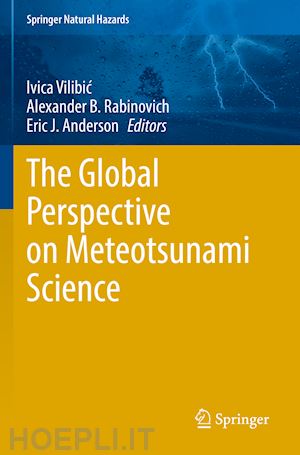

Questo prodotto usufruisce delle SPEDIZIONI GRATIS
selezionando l'opzione Corriere Veloce in fase di ordine.
Pagabile anche con Carta della cultura giovani e del merito, 18App Bonus Cultura e Carta del Docente
This book contains a collection of papers from the special issue on the global perspective on meteotsunami science, published in Vol. 106 (2) of the journal Natural Hazards. By topic, the contributions are covering overview studies, case studies of actual events, introduction of new insights into meteotsunami modelling, new techniques in meteotsunami monitoring and detection, and those describing meteotsunami operational and forecast systems. More than half of all papers describe specific meteotsunami events observed in most of the world ocean basins, some others at a rudimentary level recall previous extreme episodes, while several papers contain thorough analysis of either atmospheric conditions or oceanic sea-level response.
The book is intended for specialists in oceanography and atmospheric sciences, tsunami and fluid dynamics scientists, climatologists, coastal hazard agencies and managers, ocean engineers and many others, including students and science policy-makers, inparticular in the regions affected by this potentially destructive coastal hazard.The chapters "Proudman resonance with tides, bathymetry and variable atmospheric forcings", "Long wave generation and coastal amplification due to propagating atmospheric pressure disturbances", "On the potential of ensemble forecasting for the prediction of meteotsunamis in the Balearic Islands: sensitivity to atmospheric model parameterizations", and "Combined hazard of typhoon-generated meteorological tsunamis and storm surges along the coast of Japan" are available open access under a Creative Commons Attribution 4.0 International License via link.springer.com.
Previously published in Natural Hazards, Volume 106, Issue 2, 2021
Editorial.- Meteotsunamis at global scale: problems of event identification, parameterization and cataloguing.- On the possibility of seismic recording of meteotsunamis.- Operational tool for characterizing high-frequency sea level oscillations.- Proudman resonance with tides, bathymetry and variable atmospheric forcings.- Long wave generation and coastal amplification due to propagating atmospheric pressure disturbances.- The Mediterranean and Black Sea meteotsunamis: an overview.- The Balearic rissaga: from pioneering research to present-day knowledge,- Forecasting meteotsunamis with neural networks: the case of Ciutadella harbour (Balearic Islands).- On the potential of ensemble forecasting for the prediction of meteotsunamis in the Balearic Islands: sensitivity to atmospheric model parameterizations.- Observing meteotsunamis (“Marrobbio”) on the southwestern coast of Sicily.- Meteotsunami-related flooding and drying: numerical modeling of four Adriatic events.- The lower ionosphere disturbances observed during the chain of the meteotsunamis in the Mediterranean Sea in June 2014.- The 6–7 July 2010 meteotsunami along the coast of Portugal: insights from data analysis and numerical modelling.- Meteorologically generated long-period waves and their impact on the Dutch primary national flooding protection system.- Convective rear-flank downdraft as driver for meteotsunami along English Channel and North Sea coasts 28–29 May 2017.- Addressing the meteotsunami risk in the united states.- A high-amplitude atmospheric inertia–gravity wave-induced meteotsunami in Lake Michigan.- The meteorological tsunami of 1 November 2010 in the southern Strait of Georgia: a case study.- Meteotsunami model forecast: can coastal hazard be quantified in real time?.- Meteotsunamis in Brazil: an overview of known occurrences from 1977 to 2020.- Atmospherically induced large amplitude sea-level oscillations on October 29, 2019 at Santa Catarina, Brazil.- Numerical study of meteotsunamis driven by atmospheric gravity waves in coastal waters of Buenos Aires Province, Argentina.- Extreme sea levels at Rapa Nui (Easter Island) during intense atmospheric rivers.- Combined hazard of typhoon-generated meteorological tsunamis and storm surges along the coast of Japan.- Unexpected meteotsunamis prior to Typhoon Wipha and Typhoon Neoguri.- Numerical study on a possible cause of the ‘strange tide’ in the coastal area of Jiangsu Province, China.- Real-time pressure disturbance monitoring system in the Yellow Sea: pilot test during the period of March to April 2018.- Resonant oscillations in the western part of the Peter the Great Gulf in the Sea of Japan.- Weather radar and ancillary observations of the convective system causing the northern Persian Gulf meteotsunami on 19 March 2017.
Alexander B. Rabinovich is an internationally recognized research scientist working at the Shirshov Institute of Oceanology, Russian Academy of Sciences (Moscow, Russia)and at the Institute of Ocean Sciences, Department of Fisheries and Oceans (Sidney, BC, Canada). Dr. Rabinovich specializes in research on tsunamis, tides, seiches and other types of sea level variability. He began his work on meteorological tsunamis about 30 years ago, and is considered one of the pioneers in the examination of this hazardous phenomenon throughout the World Ocean. He is the author and coauthor of over 150 peer-reviewed publications, including articles in Science and Nature, and has been the guest editor in leading primary journals on 13 topical issues on tsunamis, tides and meteotsunamis. Since 2015, he has served as the Editor-in-Chief of Pure and Applied Geophysics, Springer (Regular issues/Atmospheric and Ocean Sciences).
Eric J. Anderson is a physical scientist at the National Oceanic and Atmospheric Administration (NOAA), USA, in Great Lakes Environmental Research Laboratory (GLERL). He has led hydrodynamic research at GLERL for over ten years and servedas the lead developer of NOAA's Great Lakes Operational Forecast System. He has focused on meteotsunami prediction since an event on Lake Erie in 2012. He is author of over 50 peer reviewed publications and received the Presidential Early Career Award for Scientists and Engineers (PECASE) in 2019.











Il sito utilizza cookie ed altri strumenti di tracciamento che raccolgono informazioni dal dispositivo dell’utente. Oltre ai cookie tecnici ed analitici aggregati, strettamente necessari per il funzionamento di questo sito web, previo consenso dell’utente possono essere installati cookie di profilazione e marketing e cookie dei social media. Cliccando su “Accetto tutti i cookie” saranno attivate tutte le categorie di cookie. Per accettare solo deterninate categorie di cookie, cliccare invece su “Impostazioni cookie”. Chiudendo il banner o continuando a navigare saranno installati solo cookie tecnici. Per maggiori dettagli, consultare la Cookie Policy.